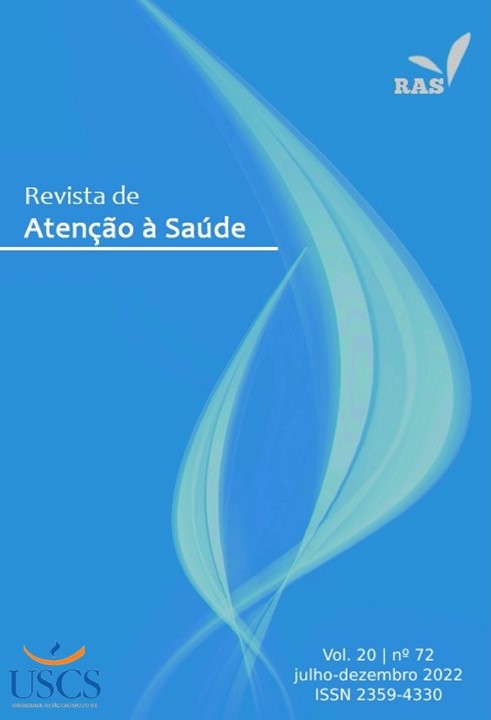Association of nutritional status with adductor pollicis muscle thickness and simplified acute physiological score in intensive care unit patients
DOI:
https://doi.org/10.13037/2359-4330.8309Keywords:
Nutrition, Intensive care units, Nutritional statusAbstract
Introduction: The use of prognostic indices and indicators to assess nutritional status can have decisive impacts on the chances of rehabilitation and survival in critically ill patients. Objectives: To assess the prevalence of malnutrition in patients admitted to the Intensive Care Unit and to verify the association between adductor pollicis muscle thickness (APMT) and the Simplified Acute Physiology Score III (SAPS III) prognostic index with the nutritional status of patients. Methods: Sixty clinical and surgical patients admitted to the adult ICU were evaluated. The assessment of nutritional status was performed in the first 48 hours of hospitalization, using the Body Mass Index (BMI) and the adequacy of the arm circumference (AC). APMT was collected from the non-dominant hand and SAPS III values were calculated and provided by the physicians responsible for the ICU. Results: The prevalence of malnutrition was 25% according to BMI and 35% according to the percentage of adequacy of AC. Eutrophic patients had significantly lower mean APMT values when compared to overweight individuals, according to BMI. Undernourished individuals, according to AC adequacy, had significantly lower mean APMT values when compared to overweight individuals. Conclusions: The prevalence of malnutrition among patients ranged between 25 and 35%, depending on the indicator used. Mean APMT values were different according to nutritional status and no association was observed between nutritional status and the SAPS III prognostic index.
Downloads
References
Junior CT et al. Prevalence rates of infection in intensive care units of a tertiary teaching hospital. Rev Hosp Clin. 2003; 58: 254-259.
Elia M, Zellipour L, Stratton RJ. To screen or not to screen for adult malnutrition? Clin Nutr 2005; 24: 867-84.
Stratton RJ, Hackston A, Longmore D, Dixon R, Price S, Stroud M et al. Malnutrition in hospital outpatients and inpatients: prevalence, concurrent validity and ease of use of the "malnutrition universal screening tool" (MUST) for adults. Br J Nutr 2004; 92:799-808.
Montejo Gonzalez JC, Culebras-Fernandez JM, Garcia de Lorenzo y Mateos A. Recommendations for the nutritional assessment of critically ill patients. Rev Med Chile 2006; 134:1049-56.
Aranjues AL, Teixeira ACC, Caruso L, Soriano FG. Monitoração da terapia nutricional em UTI: indicador de qualidade? O Mundo da Saúde. 2008; 32: 16 -23.
Plank LD, Hill GL. Energy balance in critical illness. Proc Nutr Soc 2003; 62:545-552.
Jacobs DO. Use of bioelectrical impedance analysis measurements in the clinical management of critical illness. Am J Clin Nutr 1996; 64:498S-502S.
Oliveira CPMS, Pucci N. [homepage da internet]. Avaliação nutricional em gastroenterologia. Rev Gastroenterol da FUGESP, 2002 [acesso em 08 abr 2020]. Disponível em: http://www.fugesp.org.br/nutricao_e_saude_conteudo.asp?id_publicacao=1&edicao_
numero =18&menu_ordem=4
Cheng CH, Chen CH, Wong Y, Lee BJ, Kan MN, Huang YC. Measured versus estimated energy expenditure in mechanically ventilated critically ill patients. Clin Nutr 2002; 21:165-172
Santos FA, Viana KDAL. Avaliação do estado nutricional e da terapêutica dietética de pacientes internados em uma unidade de terapia intensiva. Rev Pesq Saúde 2016; 17: 42-46.
Sungurtekin H, Sungurtekin U, Hanci V, Erdem E. Comparison of two nutrition assessment techniques in hospitalized patients. Nutrition 2004; 20: 428-32.
Rubenstein LZ, Harker JO, Salvà A, Guigoz Y, Vellas B. Screening for undernutrition in geriatric practice: developing the short-form mini-nutritional Assessment (MNA-SF). J Gerontol Med Sci 2001; 56: 366-72.
Kondrup J, Allison SP, Elia M, Vellas B, Plauth M. ESPEN (European Society for Parenteral and Enteral Nutrition) guidelines for nutrition screening 2002. Clin Nutr 2003; 22: 415-21.
Raslan M, Gonzalez MC, Torrinhas RS, Ravacci GR, Pereira JC, Waitzberg DL. Complementarity of Subjective Global Assessment (SGA) and Nutritional Risk Screening 2002 (NRS 2002) for predicting poor clinical outcomes in hospitalized patients. Clin Nutr 2011; 30: 49-53.
Waitzberg DL, Caiaffa WT, Correia MITD. Hospital Malnutrition: The Brazilian National Survey (IBRANUTRI): a study of 4000 patients. Nutrition 2001; 17: 573-580.
Fontoura CSM, Cruz DO, Londero LG, Vieira RM. Avaliação nutricional de paciente crítico. Rev bras ter intensiva 2006; 18: 298-306.
Karst, FP; Vieira, RM; Barbiero, S. Relationship between adductor pollicis muscle thickness and subjective global assessment in a cardiac intensive care unit. Rev bras ter intensiva 2015; 27: 369–375.
World Health Organization. Obesity – preventing a managing the global epidemic. Report: Genebra; 1998.
Lameu EB et al. The thickness of the adductor pollicis muscle reflects the muscle compartment and may be used as a new anthropometric parameter for nutritional assessment. Curr Opin Clin Nutr Metab Care 2004; 7: 293-301.
Pereira PML et al. Espessura do músculo adutor do polegar para avaliação nutricional: uma revisão sistemática. Rev Bras Enferm 2018; 71: 3093-3102.
Junior JMS et al. Aplicabilidade do escore fisiológico agudo simplificado (SAPS 3) em hospitais brasileiros. Rev Bras Anestesiol 2010; 60: 20-31.
Chumlea WC, Guo S, Roche AF, Steinbaugh ML. Prediction of body weight for the nonambulatory elderly from anthropometry. J Am Diet Assoc 1988; 88: 564-8
Chumlea WC, Guo S. Equations for predicting stature in white and black elderly individuals. J Gerontol 1992; 47: M197-203.
Organización Panamericana de la Salud. División de Promoción y Protección de la Salud (HPP). Encuesta Multicentrica salud beinestar y envejecimiento (SABE) em América Latina el Caribe: Informe Preliminar [Internet]. In: XXXVI Reunión del Comité asesor de investigaciones em Salud; 9-11 jun 2001; Kingston, Jamaica: OPAS; 2002.
Blackburn GL, Thornton PA. Nutritional assessment of the hospitalized patients. Med Clin North Am 1979; 63: 11103-15
Frisancho AR. Anthropometric standards for the assessment of growth and nutritional status. Ann Arbor, Michigan: University of Michigan Press; 1990.
Souza IN, Oliveira TM, Rodrigues C. Espessura do músculo adutor do polegar: uso e associação com parâmetros de avaliação nutricional em pacientes de urgência e emergência. BRASPEN J 2019; 34: 94-99.
Martins FC et al. Perfil nutricional de pacientes internados em unidade de terapia intensiva. Nutr clín diet hosp 2017; 37: 40-47.
Goldhill DR. Preventing surgical deaths: critical care and intensive care outreach services in the postoperative period. British Journal of Anaesthesia 2005; 95: 88-94.
Santos HVD; Araújo IS. Impacto do aporte proteico e do estado nutricional no desfecho clínico de paciente críticos. Rev bras ter intensiva 2019; 31: 210-216.
Glaner MF. Índice de massa corporal como indicativo da gordura corporal comparado às dobras cutâneas. Rev Bras Med Esporte 2005; 119: 243–246.
Kyle UG, Genton L.; Pichard, C. Body composition: what´s new? Curr Opin Clin Nutr Metab Care 2002; 5: 427–433.
Schleder JC et al. Relação do estado nutricional e dependência de ventilação mecânica em pacientes críticos oncológicos. Fisioter Pesq 2013; 20: 104-110.
Goulenok CMD et al. Influence of overweight on ICU mortality. Chest Journal 2004; 125: 1441-1445.
Badosa EL, Tahull MB, Casas NV, Sangrador GE, Méndez CF, Meseguer IH, et al. Hospital malnutrition screening at admission: malnutrition increases mortality and length of stay. Nutr Hosp 2017; 34: 907-913.
Correia MI, Campos AC; ELAN Cooperative Study. Prevalence of hospital malnutrition in Latin America: the multicenter ELAN study. Nutrition 2003; 19:823-5.
Ghorabi S et al. Association of the adductor pollicis muscle thickness with clinical outcomes in intensive care unit patients. Nutr Clin Pract 2016; 31: 523-526.
Goulart LL et al. Carga de trabalho de enfermagem relacionada ao índice de massa corporal de pacientes críticos. Acta paul enferm 2017; 30: 31-38.
Downloads
Published
Issue
Section
License
Copyright (c) 2023 Mariana Correia Stevenson Braga, Thaís Leo Pacheco Marcelo, Mônica Fernandez, Ana Lúcia Torloni Gradinar, Ana Carolina Almada Colucci Paternez

This work is licensed under a Creative Commons Attribution-NonCommercial-NoDerivatives 4.0 International License.
Policy Proposal for Journals offering Free Delayed Access
Authors who publish in this magazine agree to the following terms:
- Authors maintain the copyright and grant the journal the right to the first publication, with the work simultaneously licensed under a Creative Commons Attribution License after publication, allowing the sharing of the work with recognition of the authorship of the work and initial publication in this journal.
- Authors are authorized to assume additional contracts separately, for non-exclusive distribution of the version of the work published in this magazine (eg, publishing in institutional repository or as a book chapter), with the acknowledgment of the authorship and initial publication in this journal.
- Authors are allowed and encouraged to publish and distribute their work online (eg in institutional repositories or on their personal page) at any point before or during the editorial process, as this can generate productive changes, as well as increase impact and citation of the published work (See The Effect of Open Access).









